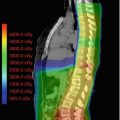© Springer International Publishing AG 2018
Anita Mahajan and Arnold Paulino (eds.)Radiation Oncology for Pediatric CNS Tumorshttps://doi.org/10.1007/978-3-319-55430-3_2323. Anesthesia for Immobilization
(1)
Department of Anesthesiology, The University of Texas MD Anderson Cancer Center, Houston, TX, USA
Abstract
Several methods of sedation have been described to enable successful treatment of children undergoing cranial irradiation. Careful planning and vigilance during the periprocedural period are essential to ensure the best outcomes. Standard monitoring and total intravenous anesthesia with or without a secure airway are common methods of anesthetic delivery. Observation in an adequately staffed and equipped recovery room should be considered for patients requiring a prolonged recovery from anesthesia.
Keywords
AnesthesiaSedationPropofolRadiotherapy23.1 Introduction
The safe and successful delivery of radiotherapy requires patients to remain immobile for a given period of time. This may be difficult in children, particularly in those younger than 4 years old. Age appropriate anxiety and the inability to lay still and cooperate during treatment are some of the challenges faced when delivering care to younger children. Although it involves a significant amount of resources, treatment under anesthesia may be safest option for some younger children.
23.2 Manuscript
23.2.1 Personnel
Due to the complex medical history of children with intracranial pathology, it is recommended that an anesthesiologist or other physician trained and experienced in pediatric perioperative care be involved in providing sedation. Pediatric advanced life support certification is also recommended for anesthesia and nursing staff involved in the care of pediatric patients.
23.2.2 Treatment Room Set Up
Radiotherapy suites should ideally possess the oxygen delivery and suction outlets. Backup oxygen supply cylinders are recommended, and extra connection tubing may be needed to reach oxygen supply and suction outlets. Gas evacuation outlets will enhance the ability to use an anesthesia machine if needed. In any case, an anesthesia ventilator should be readily available.
23.3 Supplies
Most radiotherapy suites are located at a considerable distance from the main operating rooms. As a result, anesthesia equipment, supplies, and medication may not be readily available. It is, therefore, essential that carefully stocked supply carts and medication trays are available. These conditions may necessitate customizing existing supply kits to ensure availability of the most commonly used items.
23.3.1 Airway Supplies
In addition to appropriately sized endotracheal tubes and laryngoscopes, extra supplies of nasal cannulas, facemasks, and laryngeal mask airways (LMA) are required since these are most frequently used in this setting. Appropriate positive pressure ventilation systems for infants and children, and various sizes of oropharyngeal and nasopharyngeal airways should also be available.
23.3.2 Vascular Access Devices
Most children undergoing cranial irradiation will have some form of central venous access. Port-a-Cath access is usually performed at the beginning of the week, and de-accessed over the weekend if appropriate. As such, local anesthetic creams, access needles, and special sterile access kits should be readily available. Central line dressing kits and heparin flushes should also be available.
23.3.3 Medication
A complete set of anesthesia and emergency drugs with a written pediatric dose schedule should be immediately available. In addition, an institutional emergency cart complete with pediatric defibrillator paddles, and vasoactive drugs should be immediately available in the treatment area. The latter will enable familiarity with the location of equipment and supplies in the event that help is required from other services at the hospital. Propofol is a commonly used anesthetic in this setting. Extra supplies of this medication with the appropriate delivery equipment should be stocked.
Stay updated, free articles. Join our Telegram channel

Full access? Get Clinical Tree








